There is a continuous growth in the use of smartphones and other high tech devices. Yet, simple gadgets like pagers have continued to remain relevant in our daily routine. The first communication pager was patented in 1949 by Alfred J. Gross.
Pagers are used by emergency services and public safety personnel until this day. It was not until the 2000s that pagers became a feature in service delivery in restaurants.
The restaurant paging system is now used by restaurants to effectuate excellence. We will focus our attention on how restaurants are making use of pagers in their business. We will also examine in brief the different types of restaurant pagers available.
What are restaurant pagers used for?
Have you been to that your favorite restaurant recently to meet a full diner with no free table? A second look at the queue and all you can think of is going elsewhere or coming back later.
Restaurant managers now issue customers simple pagers. This gadget allows you to have a drink nearby or take a stroll and get a beep immediately; a table becomes vacant. This replaces calling of names over the counter or using a public address system.
This helps to commit a customer that would have looked for another diner to remain on your list. The pager with a radius of about 2 kilometers can be used as an efficient queue management system.
This encourages customers to remain around the vicinity rather than clogging around the diner. It also helps in reducing the number of customers who get frustrated and leave. This then leads to increased revenue and repeat business.
Types of Restaurant Pagers
Pagers vary from very cheap and simple equipment. Then, you will find complex and expensive personal communication gadgets. We will limit our focus on five basic pager types that are more common to find in your next visit to the restaurant:
1) Beeper:
These kinds of beepers are the earliest and cheapest type of pagers. It derived its name beeper from its ability only to make a beeping sound. Lavu POS makes use of those pagers for example.
But, recent pagers in this category now make use of other forms of alert as well. Some use audio signals, light up and some vibrate, while others use any combination of the above.
Being the most basic type of pagers, they are most likely the ones you have seen in a restaurant near you. Once you get a notification, it means that your table is ready and your attention is needed at the diner.
2) Voice/Tone:
As the name implies, it enables the pager user to listen to a recorded message at the prompt of an alert. It receives notifying alerts like beepers, but it goes a step further with the voice message. This voice message can be replayed back upon receipt.
The voice tone could be a simple message informing the customer of the availability of a table. It could also be to apologize for unexpected delays in the service delivery process.
3) Numeric:
Pagers in this category appear to be the easiest and simplest to use. They can receive numbers dialed from a phone. It has a numeric LCD that is capable of displaying numeric information up to 10 digits.
This could likely be the number of the hostess in-charge of your table. The numeric pager uses any of the notifying alerts before the numeric displays.
4) Alphanumeric:
Alphanumeric pagers have a more sophisticated LCD. It’s capable of displaying both numbers and alphabets. It receives message notifications often through email or direct connection to the system.
It can be used to inform the client on updates as regards the diner. It could be a simple message informing about how much time before the table would be ready.
5) Two-way:
As the name implies, this device allows you to send data as well as receive it. They are sometimes called response pagers with built-in QWERTY keypads.
They are the ultimate type of restaurant pagers. It has the ability for back and forth communication between the customer and the diner staff.
It comes with the usual notifications, which could be a simple tone, light or vibration of the pager. A client can reply to the diner to inform them that he has received the message but might take longer to be at the table. The customer can also use the pager to pick a menu pending his arrival.
It’s obvious that the more advanced your pager is, the more benefits and satisfaction you will gain from its use. Restaurants use small desktop transmitters with a short radiofrequency to reduce cost, instead of relying on network towers. Pagers are usually integral part of Restaurant POS systems.





